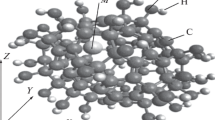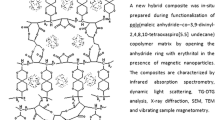Abstract
Melamine cyanurate and melamine barbiturate self-assembled materials were prepared and studied by the electron paramagnetic resonance (EPR) spectroscopy, optical and scanning electron microscopy, X-ray powder diffraction (XRD). Both optical and electron microscopy show the formation of microscale crystalline particles possessing complex layered structures with a highly stable appearance. Both assemblies tend to form twinned crystals, which in the barbiturate case leads to multiple twinning in every particle. Optical microscopy shows high anisotropy and birefringence of both materials. XRD data represent a high crystallinity of melamine barbiturate and much lower for melamine cyanurate. Studied materials reveal the ability to incorporate radicals that correlate with their crystal structure quality. It is attributed to the structure-dependent stabilization of active radical superoxide species in structure voids or defects. In the example of melamine barbiturate, it is shown that the number of active paramagnetic centers increases at ca. 22% when a substance is irradiated with UV + Vis light. It reaches saturation in approximately 20 min, whereas only ca. 14% decrease was observed in a week.







Similar content being viewed by others
Data Availability
All data available from the corresponding author on request.
References
P. Fattibene, F. Callens, Appl. Radiat. Isotopes 68, 2033–2116 (2010)
C.-T. Yang, A. Hattiholi, S.T. Selvan, S.X. Yan, W.-W. Fang, P. Chandrasekharan, P. Koteswaraiah, C.J. Herold, B. Gulyas, S.E. Aw, T. He, D.C.E. Ng, P. Padmanabhan, Acta Biomater. 110, 15–36 (2020)
Y.V. Gorelkinskii, N.N. Nevinnyi, Phys. B: Condensed Matter 170, 155–167 (1991)
J. Xiong, J. Di, J. Xia, W. Zhu, H. Li, Adv. Funct. Mater. 180, 2018 (1983)
L.D. Bogomolova, V.A. Jachkin, S.A. Prushinsky, S.V. Stefanovsky, Y.G. Teplyakov, F. Caccavale, J. Non-Cryst. Solids 220, 109–126 (1997)
M.A. Borik, R.M. Eremina, E.E. Lomonova, V.A. Myzina, V.V. Osiko, I.I. Fazlizhanov, V.A. Shustov, I.V. Yatsyk, Mod. Electron. Mater. 3, 95–98 (2017)
M.Y. Ivanov, M.V. Fedin, Mendeleev Commun. 28, 565–573 (2018)
G. Whitesides, J. Mathias, C. Seto, Sci. 254, 1312–1319 (1991)
T.J. Prior, J.A. Armstrong, D.M. Benoit, K.L. Marshall, CrystEngComm 15, 5838 (2013)
K. Rovina, S. Siddiquee, J. Food Compos. Anal. 43, 25–38 (2015)
V.V. Shilovskikh, A.A. Timralieva, P.V. Nesterov, A.S. Novikov, P.A. Sitnikov, E.A. Konstantinova, A.I. Kokorin, E.V. Skorb, Chem. Eur. J. 2, 2 (2020)
H.C. Garcia, R. Diniz, M.I. Yoshida, CrystEngComm 11, 881 (2009)
A.Kh. Vorobiev, N.A. Chumakova, Nitroxides: Theory, Experiment and Applications (InTech Publ, Rijeka, 2012), pp. 57–112
J.B. Weber, Res. Rev. 32, 93–130 (1970)
M.J. O’Neil, J. Am. Chem. Soc. 129, 2197 (2007)
N. Türkel, M.S. Aksoy, ISRN Anal. Chem 2, 1–5 (2014)
J.W.P. Schmelzer (ed.), Nucleation Theory and Applications (JINR, Dubna, 2005)
K. Sangwa, Nucleation and Crystal Growth: Metastability of Solutions and Melts (Wiley, New York, 2018)
F. Kalischewski, I. Lubashevsky, A. Heuer, Phys. Rev. E 75, 2 (2007)
C. Zhao, Z. Chen, J. Xu, Q. Liu, H. Xu, H. Tang, G. Li, Y. Jiang, F. Qu, Z. Lin, X. Yang, Appl. Catal. B Environ. 256, 117867 (2019)
E.R. Draper, L.J. Archibald, M.C. Nolan, R. Schweins, M.A. Zwijnenburg, S. Sproules, D.J. Adams, Chem. Eur. J. 24, 4006–4010 (2018)
Acknowledgements
This work is supported by the Ministry of Science and Higher Education of the Russian Federation, goszadanie no. 2019-1075. ITMO Fellowship and Professorship program 08-08 is acknowledged for infrastructural support.
Author information
Authors and Affiliations
Corresponding author
Ethics declarations
Conflict of interest
Authors declare no conflicts of interest.
Additional information
Publisher's Note
Springer Nature remains neutral with regard to jurisdictional claims in published maps and institutional affiliations.
Rights and permissions
About this article
Cite this article
Shilovskikh, V.V., Timralieva, A.A., Belogub, E.V. et al. Radical Activity of Binary Melamine-Based Hydrogen-Bonded Self-Assemblies. Appl Magn Reson 51, 939–949 (2020). https://doi.org/10.1007/s00723-020-01254-6
Received:
Revised:
Published:
Issue Date:
DOI: https://doi.org/10.1007/s00723-020-01254-6




